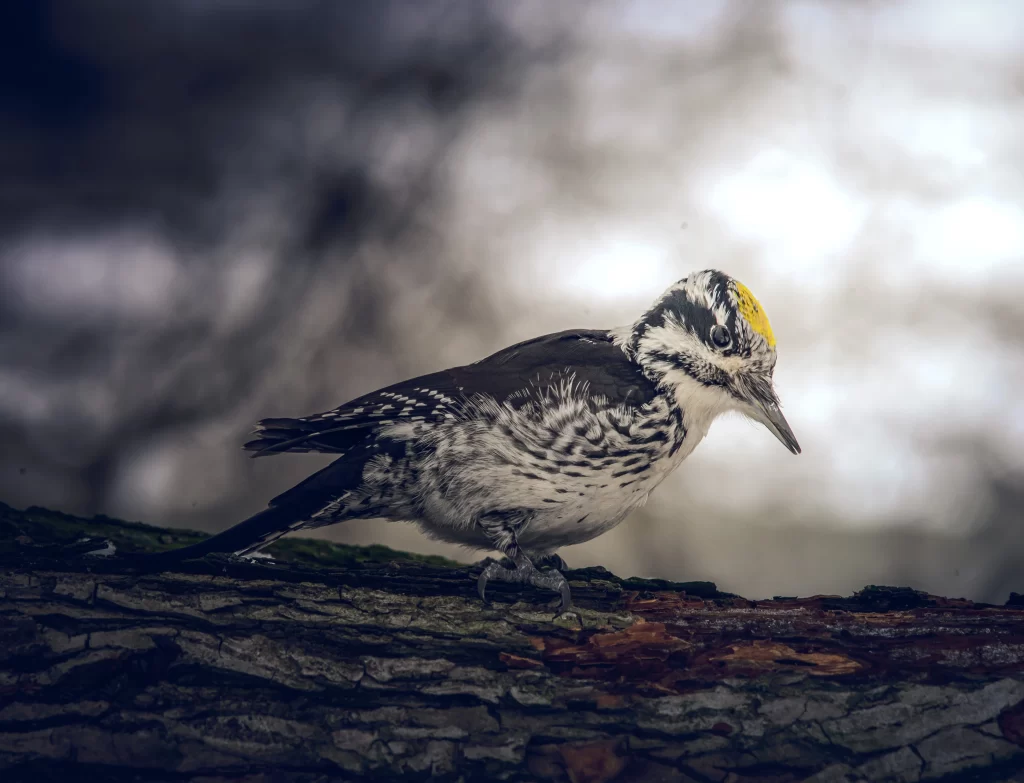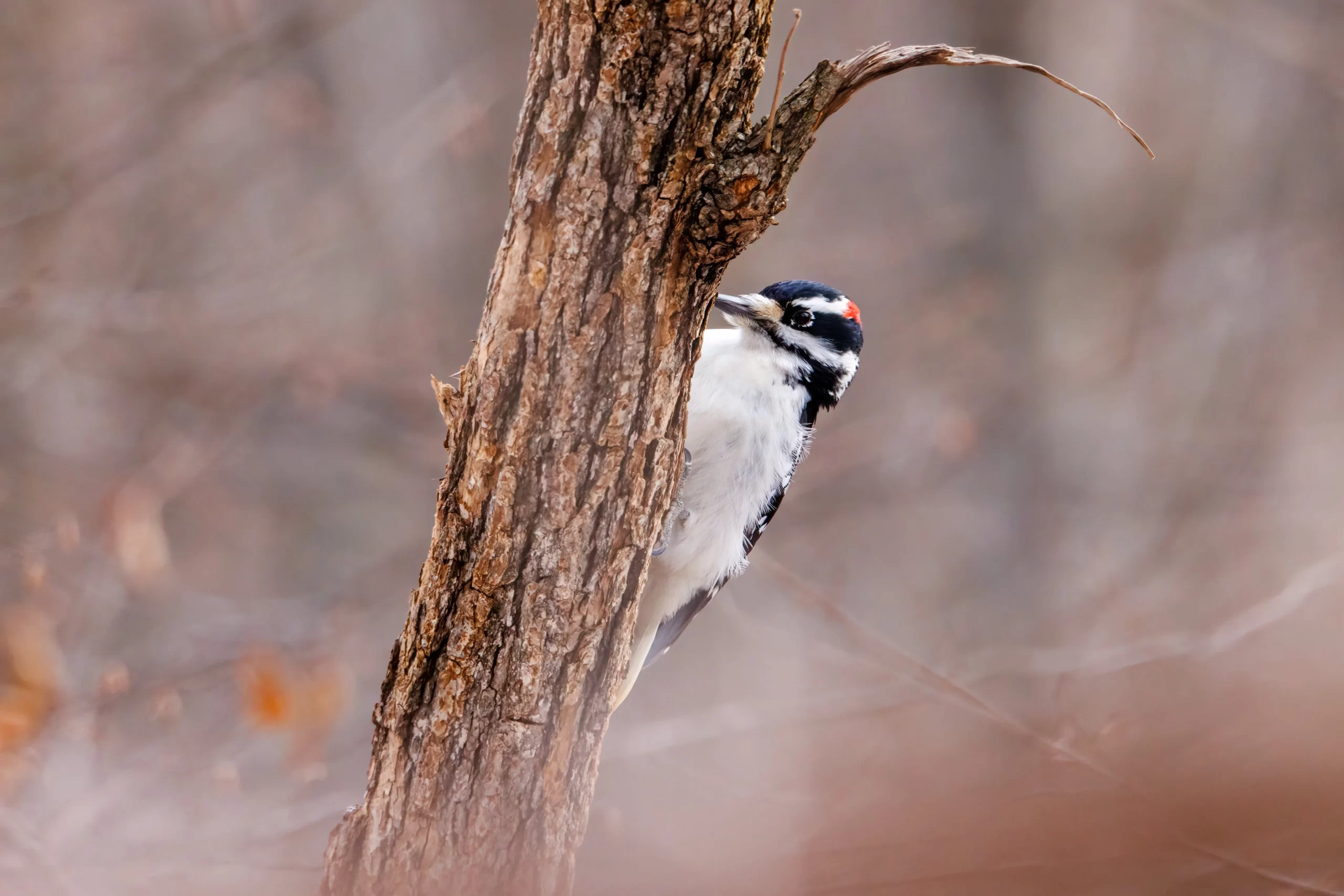Ontario is home to innumerable bogs and large swaths of untamed boreal forest. Therefore, it should not be surprising that the Canadian province has an impressive array of woodpeckers within its borders. Indeed, 9 woodpeckers in Ontario can be found within the province annually.
Some Ontario woodpeckers will readily visit backyard bird feeders to grab a bite to eat, as all Ontario woodpeckers love eating seeds, suet, and insects. While some woodpeckers visit feeders, others are shy birds that won’t readily venture out of the forest.
If you’re hoping to learn all about Ontario woodpeckers, you’ve come to the right place! Continue reading as I describe everything you wish to know about the types of woodpeckers in Ontario.
Table of Contents
9 Ontario Woodpeckers
American Three-toed Woodpecker

Identification
American Three-toed Woodpeckers measure 8.25 – 9 inches (21 – 23 cm) long. Both males and females have a white patch with black barring on their backs. Moreover, their undersides are also white with black barrings, while their wings are black. Males have a distinctive yellow forehead patch.
Habitat and Range
American Three-toed Woodpeckers are closely associated with Ontario’s boreal forests. Here, these woodpeckers in Ontario make their homes and live the entirety of their lives. They prosper in areas that have experienced some sort of disturbance (such as a fire or storm damage), as this results in insects becoming especially numerous in these areas.
The central portion of Ontario is the best place to locate these woodpeckers. They are rarities in southern Ontario near Toronto, and they are not numerous in the north where grassy, wet habitat becomes the norm.
Status
American Three-toed Woodpeckers are present throughout the year in Ontario, but don’t get the wrong idea – these birds are far from common. Those who hope to see them will have to venture into the boreal forest and seek out areas that have been disturbed in the past few years. Overall, they are likely the rarest Ontario woodpecker.
Black-backed Woodpecker

Identification
Black-backed Woodpeckers measure about 9 inches (23 cm) long. They are similar to the American Three-toed Woodpeckers in many respects. However, Black-backeds can be distinguished by their entirely black namesake backs. Their undersides are white with black barring. Males have a yellow forehead patch, while this is absent in females.
Habitat and Range
Black-backed Woodpeckers have strong ties to areas of forest that have recently been burned. They prefer to inhabit coniferous forests, but they may also be found in deciduous forest if it was recently burned. Black-backed Woodpeckers may be found in such tracts of forests for as much as eight years following a burn.
The boreal forest region of Ontario is the best place to look for Black-backed Woodpeckers. Therefore, anywhere save for the central portion of the province is unlikely to produce this species.
Status
Black-backed Woodpeckers remain in Ontario throughout the year. Aside from the American Three-toed Woodpecker, they are the second-rarest woodpecker in Ontario.
Downy Woodpecker

Identification
Downy Woodpeckers are the smallest woodpeckers in Ontario, as they measure about 6 to 6.5 inches (~15 – 17 cm). They have short bills with plain white undersides, black wings with white speckles, and a white patch on their backs. Males have a red patch on the backs of their heads that is lacking in females.
Habitat and Range
Downy Woodpeckers are quite versatile, being found in parks, backyards, suburbs, and other areas with open woodlands. They regularly visit bird feeders.
This Ontario woodpecker is absent from the northern third of the province, but they are abundant woodpeckers of southern Ontario.
Status
Downy Woodpeckers are certainly a contender for the most common woodpecker in Ontario. They are readily observed without much effort.
Hairy Woodpecker

Identification
Hairy Woodpeckers measure 8 – 10 inches (~20 – 25 cm) long. They look like larger versions of Downy Woodpeckers, as they are a black and white woodpecker with similar patterning and sexual dimorphism. Note the proportionately longer bill of a Hairy.
Habitat and Range
Hairy Woodpeckers are adaptable, being present in the boreal forests but also the deciduous forests of the south. They merely require mature woodlands that feature dead or decaying trees in which they can forage.
Hairy Woodpeckers are perhaps the most widespread woodpecker in Ontario, with few areas not hosting these creatures. They’re even regular northern Ontario woodpeckers.
Status
The extensive range of Hairys makes them among the easiest woodpeckers to find. Listen for their piercing, abrupt “peek” call notes.
Northern Flicker

Identification
Northern Flickers measure 11 – 12 inches (28 – 30.5 cm) long. They are beige-coloured woodpeckers with black chest bibs, dark brown backs, and yellow tail feathers. Males have a black mustache that separates them from females.
Habitat and Range
Northern Flickers are not adept at navigating the boreal forest like some of the other types of woodpeckers in Ontario. Instead, they prefer forest edges, parks, and cemeteries.
They are one of three migratory woodpeckers found in Ontario, with most birds departing by October and heading south. During the breeding season, these Canadian woodpeckers can be found in nearly all of the province.
Status
A small number of Northern Flickers can usually be found in the winter in southern Ontario, but it is rare to find one elsewhere during the winter. This Ontario woodpecker is quite common in the summer, so finding one during this time is usually easy.
Pileated Woodpecker

Identification
Pileated Woodpeckers are easy to identify with their large size, as they measure 16 – 19 inches (40.5 – 48.5 cm) long. No other woodpecker in the province comes close to the size of a Pileated, as they’re the largest woodpecker in Ontario by far. They have black bodies, white wing patches, and red crests. Males have more red on the face than females, but they are otherwise similar.
Habitat and Range
Pileated Woodpeckers seek out sizable tracts of forest as their preferred habitats. They don’t thrive in purely coniferous forests like American Three-toed and Black-backed Woodpeckers. Instead, these woodpeckers of Ontario prefer mixed forests or those that are mostly deciduous. They may be found in residential areas if trees are numerous and mature enough.
These woodpeckers in Ontario aren’t present north of the central portion of the province, and they can be found at any time of year. Pileated Woodpecker pairs are loyal to their territories, and they may be found in the same area for many year.
Status
Pileated Woodpeckers are regular but uncommon in Ontario. They require sizable territories, so pairs often keep a considerable distance apart.
Red-bellied Woodpecker

Identification
Red-bellied Woodpeckers measure 9.5 inches (24 cm) long. These woodpeckers of Ontario have bold zebra patterning on their backs, and their undersides are pale and unmarked. Males have red hoods, while females only have partial hoods.
Habitat and Range
Red-bellied Woodpeckers have adapted to thrive in most places with decent tree cover. Therefore, forests, backyards, parks, and suburban areas are all enticing to these woodpeckers in Ontario.
They are a southern Ontario specialty, being common around Toronto and its suburbs. However, they avoid the remainder of the province due to the cold weather that takes place in winter.
Status
Red-bellied Woodpeckers are common in southern Ontario woodpeckers, but they should be considered rare and noteworthy anywhere north of Sudbury.
Red-headed Woodpecker

Identification
Red-headed Woodpeckers measure 7.5 – 9 inches (19 – 23 cm) long. This Ontario woodpecker is sexually monomorphic, having a red head, white undersides, and black and white checkboard wings.
Habitat and Range
Red-headed Woodpeckers thrive in open, deciduous woodlands. Therefore, they avoid the boreal forest region of Ontario.
Red-headed Woodpeckers are another southern Ontario specialty. Observing one north of Parry Sound is notable.
Status
Red-headed Woodpeckers are uncommon summer residents in Ontario. They are the rarest migrant woodpecker in the province, and populations of these woodpeckers in southern Ontario are experiencing rapid declines.
Yellow-bellied Sapsucker

Identification
Yellow-bellied Sapsuckers are 7 – 8.75 inches (18 – 22 cm) long. Males have red throats, while females and immatures lack this feature. Otherwise, these woodpeckers in Ontario look similar, with both sexes having black wings, black and white checkered backs, and pale barred undersides.
Habitat and Range
Yellow-bellied Sapsuckers do not like the mature boreal forests that many other Ontario woodpeckers enjoy. Instead, these Canadian woodpeckers seek forest edges and young forests. Here, they drill sap wells into trees that attract insects. Some worry that these sap wells harm trees, but studies have shown that the damage is minimal.
Yellow-bellied Sapsuckers are a migratory woodpecker that arrives in April and departs by October. They breed from central Ontario south.
Status
Yellow-bellied Sapsuckers are rather easy to observe, as they are vocal birds that are found in habitats that aren’t as challenging to navigate as mature boreal forests.

